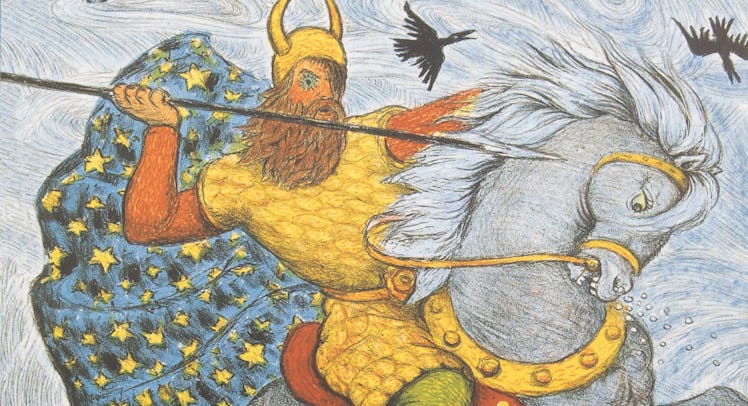50 Years Later, D’Aulaires’ ‘Book of Norse Myths’ Remains a Classic
There is no better way to introduce your kid to the rich mythology of the ancient Nordic culture.

Thor: Rangarok storms into theaters this weekend without his hammer but packing a lot of technicolor action and adventure. Whether or not you decide to take your kids, it’s an excellent opportunity to educate them on the rich history of Norse mythology. And there’s no better way to do that than through D’Aulaires’ Book of Norse Myths. The classic serves as the perfect introduction into the wide-ranging, fascinating, and extremely weird world of mythical figures.
Book of Norse Myths was first published back in 1967, as a follow-up to Ingri and Edgar Parin d’Aulaire’s popular Book of Greek Myths, which came out five years earlier. The book was a huge success but went out of print for several decades. In 2005, it was reissued and rereleased and has since remained a beloved staple for parents and children alike, surpassing all of the d’Aulaire’s other work in terms of popularity.
Why is Norse Myths such an enduring classic 50 years after its initial release? There are plenty of reasons, chief among them being the fact that even thousands of years later, the stories of Odin, Thor, and Loki continue to be as engaging as they ever were. The old myths have everything you would want in a supernatural soap opera: acts of bravery, family drama, shocking betrayals, and even a bit of boozing left in for good measure.
Barnes & Noble
In Norse Myths, the characters with whom your kid might already be familiar are more fully realized and dynamic than their Marvel counterparts. Odin is the powerful but unpredictable ruler and father to Thor; the hammer swinging god of thunder is noble but also a bit of an egotistical baffoon; and Loki is the untrustworthy but effortlessly charming god of mischief. These characters, though placed within storylines that are toned down for children (free of the hardcore sex and violence that populates the original tales)— are rendered in a way that keeps them true to their original ideas. Loki is best of all, as he’s a character who gets endless joy out of artfully deceiving Thor, even if deep down he knows he will always be caught. He’s driven by anger and resentment and is not heroic; kids will still cheer during his more clever and ambitious schemes.
The stories also have a refreshing cohesion that is missing from other culture’s mythology due to most of the Nordic myths coming from two ancient texts known as the Prose Edda and the Poetic Edda. This makes it much easier for modern readers, as historians are not forced to piece thousands of different sources together in the hopes of discovering a semi-connected narrative.
Ultimately, Book of Norse Myths has maintained its esteemed reputation thanks to being a fun, informative retelling of one of the richest mythologies in human history. And if you are hoping to raise a kid who really knows their myths, this is definitely the book for you. Just watch out if your kid relates too much to Loki because they may use the stories as inspiration as they start to secretly scehem around the house.
This article was originally published on